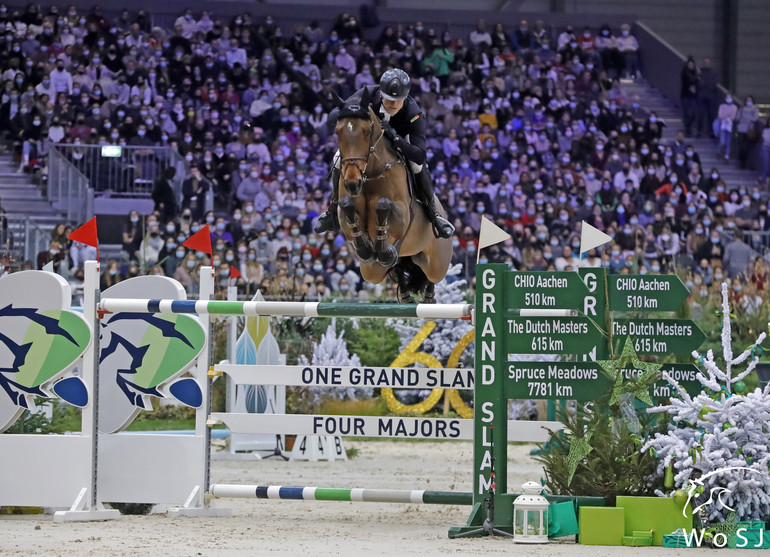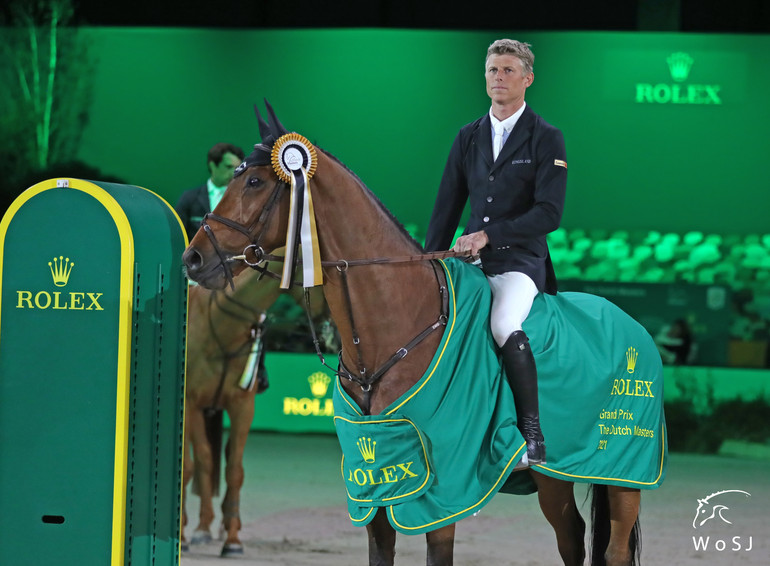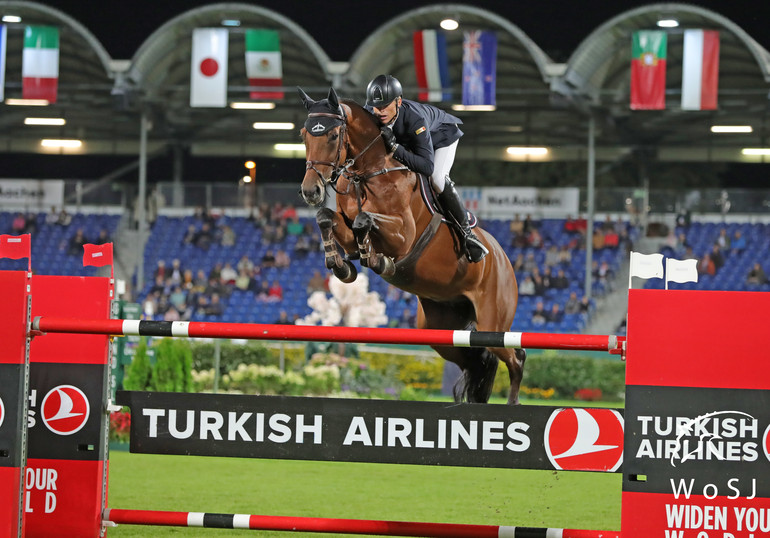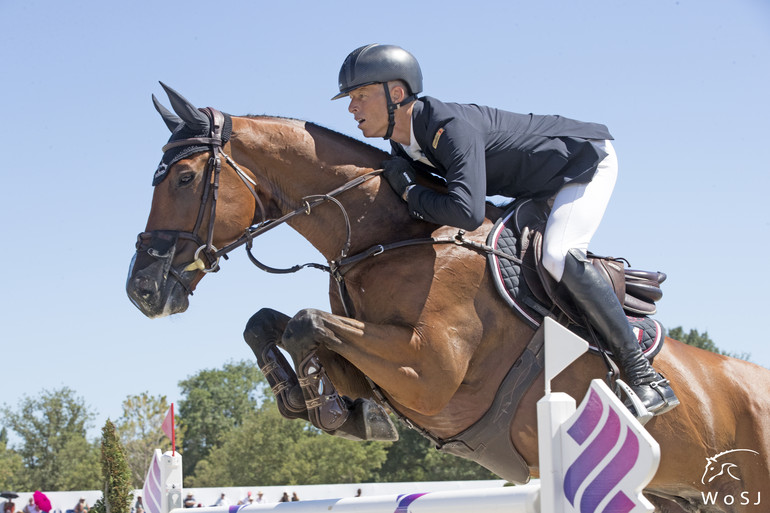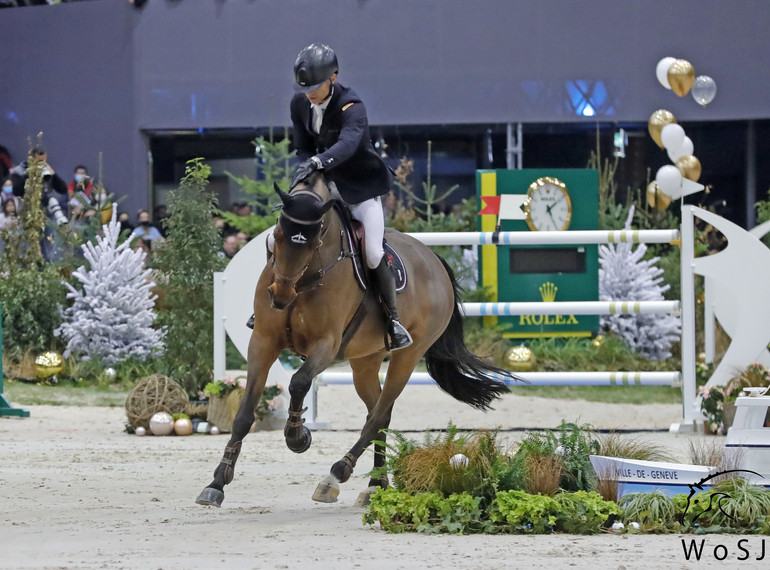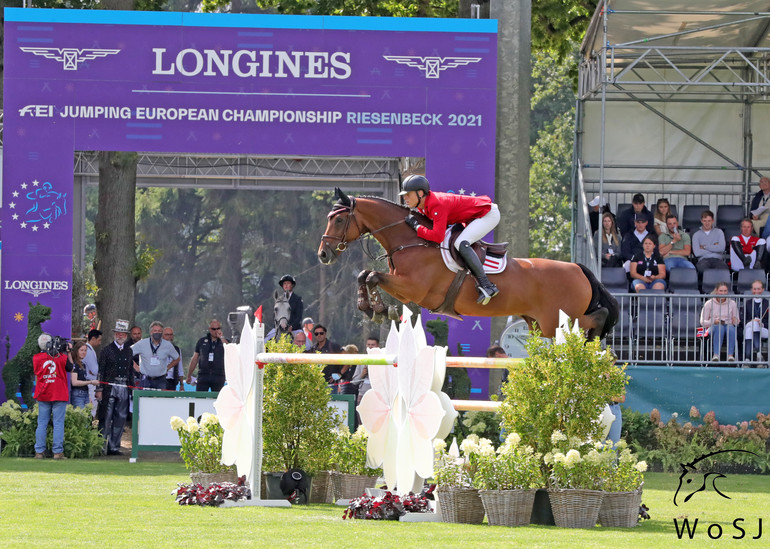Text © World of Showjumping
Last year, Elektric Blue P (Eldorado vd Zeshoek x For Pleasure) – bred by the Pfitzmann-family – and Max Kühner won the Rolex Grand Prix at the Dutch Masters, the Turkish Airlines Prize of Europe at CHIO Aachen, represented Austria at the Longines FEI European Championships in Riesenbeck and concluded 2021 with a second place in the Rolex Grand Prix of Geneva. World of Showjumping spoke with Elektric Blue P’s breeder Tobias Pfitzmann and his rider Max Kühner, who discovered his top mount at the age of two and carefully brought him up to the highest level. “He is definitely one of my best horses, even though it is always hard to say one is the better than the other,” Kühner says about the now 11-year-old gelding.
Elektric Blue P was born at a farm near Berlin, where the Pfitzmann-family breeds horses and cattle. “Every year, eight to ten foals are born, which we raise ourselves, prepare for licensing and start training for the sport,” Tobias Pfitzmann tells. “The young horses stay completely outside from the age of one until we start working with them. As a result, our horses are very healthy, powerful and resilient. The story of Elektric Blue P actually starts with his great-grandmother Orientsonne xx, which I bought as a three-years-old in very bad condition. I cared for her, and when she was better, I started breeding with her. She is represented in our breeding program through two daughters: Frühlingssonne by Frühlingsbote – who produced seven successful sport horses – and Carisma P by Carismo, whose daughter French Kiss P by For Pleasure is the dam of Elektric Blue P.”
“Blue was her first foal,” Pfitzmann continues. “Even though I rarely use young stallions, I liked Eldorado so much that I chose him for French Kiss P. We also have Eldorado-offspring out of other mares that jump very well. Like all our horses, we got Blue ready for the stallion approval ourselves. He never jumped spectacular, but always with a lot of overview, good through the body and was careful – the way we want our horses to be. Blue was a bit smaller and didn't look like a stallion, but he was a great horse already then. He was not licensed, because in Germany stallions have to have a certain type, which is something I don’t fully agree with. Our young stallions are in a herd on permanent pasture until the end of their second year, and I do not prepare my horses just to make them jump spectacularly on one occasion. It is nice to have a licensed stallion, but it is even nicer when the horses are successful in the sport later on. And that's what all our horses do and they also grow old in sport. When we went to this stallion approval in Munich, it was with the intention to sell. Max Kühner recognized Blue’s talent and bought him.”
The first time Kühner saw Elektric Blue P was at the DSP stallion approval (Deutsches Sportpferd – Süddeutsche Pferdezuchtverbände), the winter that he turned three. “I went there for their auction and happened to see Blue coming into the ring,” Kühner recalls. “I saw one jump on the screen, and it was exactly as he does it today – without any effort. You could tell that he very easily could repeat this kind of jump, it was so natural for him. While Blue was not approved, I was still really amazed by this one jump. Eberhard Senkenberg was sitting next to me, and said the horse had been jumping just as good already in the pre-qualifier – he thought it would be a good sport horse. Henrik Gravemeyer also told me there was one horse I should look at, a horse he had really liked, which had not been approved. And that horse was Elektric Blue P. These two men had a really good feeling about the horse, and I bought him immediately.”
“Blue was not a warmblood stallion-type, he looked more like a thoroughbred,” Kühner continues. “We castrated him right after the stallion show, and then saddle broke him. He jumped just as good under the saddle. Our system with the young horses is that we work with them a few months, and then they go back to the field – and Blue did the same. Until his seventh year, he lived out in the field in a group. Before leaving to the Sunshine Tour that year, he was still standing outside in the snow.”
“We have a lot of young horses and we have no plans of selling them, we only want to build them up and give them time to develop,“ Kühner explains about the system he has in place. “Our young horses, they don’t have to shine: They don’t have to be super competitive; they don’t have to jump spectacular, we simply compete them to get to know them. We want to see how they develop without any pressure. For three to four months at a time we build them up, go to the shows and then we put them back in the field – and after a break, we start again from scratch. This way, you see the talent of a horse; how easy they learn. I don’t think it’s good to leave horses jumping on a high level all the time. You can ask them to develop – and this can happen quickly – but then you have to let them rest. For me, this is really important: It is not about building up the horses by asking more and more, but by taking steps back and forth. The better the horse, the easier it is for them to start over. Usually, we never compete them internationally until they are six or seven, in most cases my rider Helmut Schönstetter brings them to the Sunshine Tour to get them slowly going in the international classes.”
For Blue, everything was easy, Kühner tells. “Whatever you asked from him, he did. Helmut competed Blue until he turned six, then I took over the reins and already as an eight-year-old he had results in five-star Grand Prix classes. However, he got a bit tense from time to time, he was always sensitive, and it has been important to present things to him in a very relaxed manner. Even today, when I ride him, I prefer him being relaxed rather than perfect: I don’t need to have every kilogram in the right place, it is more important that he stays calm. Sometimes I miss the last bit of perfection – but that is the way he likes it. If he gets tense, he is not as good as he can be.”
“He is a very intelligent horse,” Kühner says about Blue’s personality. “For example, a few months ago a horse from a colleague jumped away from the side and bumped into him. He did not get hurt, but three months later, when the same horse was about to pass us, Blue jumped away five meters before. He never did this with any other horse, but only with this one – he remembered. He is also the kind of horse that does not make the same mistake twice. Because he is very intelligent he is also constantly progressing. He is very easy to handle and we try to keep his program really varied with hacking out, cantering in the hills, not doing the same too much, because he gets easily bored. He is a very competitive horse; in a jump-off he goes with you. He is not a horse you have to ask twice; he goes for it from the first stride.”
“I get this question a lot, but I never did it in any other way,” Kühner says when asked about having found his super-star at such a young age and having produced him all the way to five-star level. “The only horse I had that competed a lot before coming to me was PSG Future, but all my other horses I have had since they were very young. Chardonnay we had since he was a foal, so for me this is the normal way. Usually, I ride all of the young horses from they are six, some even when they are younger. Often, people argue that my young horses compete early in bigger classes, but when we have them for a long time in our system, I think we know the horses very well. We don’t do much with the four- and five-year-olds, but we get them going. However, we can already practice important things with them so that we don’t have to do that when they are eight: We have great training facilities at our place, so the five-year-olds can already jump the water, the double ditches, they jump next to a lake. I think this is the best education they can have. For me, having the horses from a very young age is the best way: I get to know them inside-out.”
As a 9-year-old, Elektric Blue placed second in the CSI5* 1.60m Commercial Bank CHI Al Shaqab Grand Prix presented by Longines in Doha – right behind Killer Queen VDM, who is also by Eldorado vd Zeshoek out of a For Pleasure-mare. “Of course, I talked a lot about it with Daniel [Deusser],” Kühner says about the matching pedigrees. “Obviously the combination with Eldorado and For Pleasure is working. However, if I see both horses, I could not tell that they have such a similar breeding: They have the same colour but the type is really different. Killer Queen is a bit stronger, heavier; Blue is very light. Also, with the riding, we ride Blue in a normal snaffle, he is really easy in the mouth.”
“The wins in s’Hertogenbosch and in Aachen were great moments with Blue last year,” Kühner says. “I believe there is more to come though – it was close in Geneva, I think I added one stride too much, otherwise we might have won. That was more on myself than him though! I would really like to see Blue do well at a major championship; he is such a consistent horse.”
No reproduction without written permission, copyright © World of Showjumping



